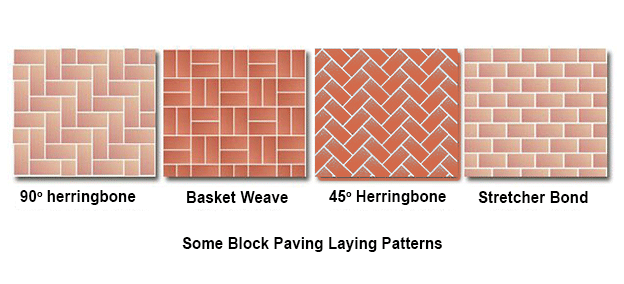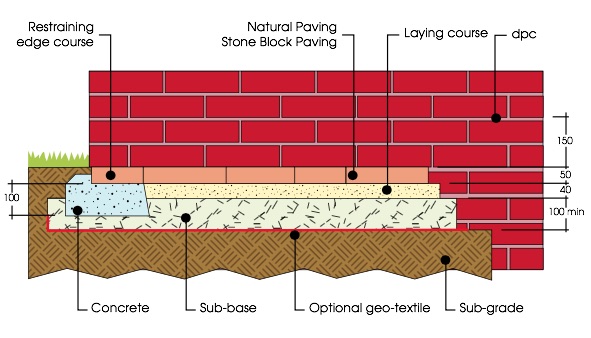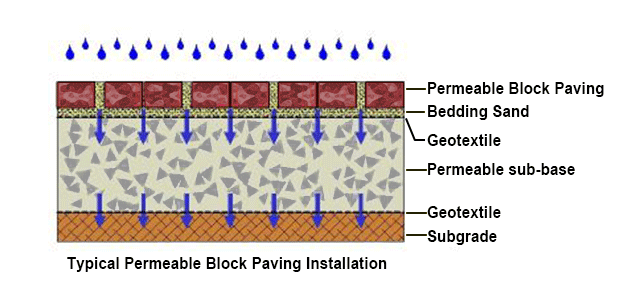Uses and Applications
Mass production has seen block paving reduce in price, which in turn has seen this method of outdoor covering become the most significant growth area in the UK the paving industry over the last 30+ years. It has made block paving affordable for most projects with a vast choice of design and colour available.

Brick and Block Paving
Brick and block paving can be used anywhere you would have seen the more traditional covering such as Tarmacadam or Tarmac and plain old concrete. Aesthetically they are much more pleasing to the eye than the other alternative and can also be mixed with the other methods to give a durable and practical finish. They are an active surface for Patios, Drives and Paths and with the infinite choice of pattern and design suit most areas.
Brick and Block Paving What’s the Difference?
There are two types of block paving; Concrete and Clay, concrete block pavers (CBP) and kiln-fired bricks, that’s how you get the terms Brick or Block. For the understanding of this guide from here on the concrete types will be referred to as blocks and clay as bricks. You will also see them described as pavers, paviours or paviors not wanting to confuse anyone!
Blocks and Bricks range of thicknesses, from 50mm to 100mm for domestic use 50mm and 60mm are the most commonly used. Given the broad range of products available these days, choosing can be an involved process, that’s why ACS staff are here to help you with this decision, using our decades of experience to guide you on your choice.
Let’s look at concrete blocks and clay bricks in more detail
Concrete blocks give by far the broadest range of variety of size, shape, textures and colours. Each manufacturer produces there own version of the standard block and will also have a range of uniquely shaped and textured blocks.
The standard rectangular block is moulded to a specific size, 100mmx200mmx50-100mm, giving you exactly 50 blocks per sq meter. This standardisation allows blocks from different manufacturers to be mixed. They tend to have one presentable face with a few blocks being reversible. The benefit, for example, is, if you had your drive block paved and a vehicle dropped oil over time, we could return and reverse the brick and repair the stained paving area.
During the manufacturing process, concrete dyes are added to achieve the desired colour; this is generally in some form of metallic oxide. Even so, concrete blocks are prone to fading when subjected to natural daylight over time. The quality of dye used can have an important factor in the block price; manufacturers do not consider fading to be a reason for complaint, so bear this in mind when making your decision. To put this into perspective, the fading is over many years even with the economy blocks.
What’s the difference between Through-colour and face-mix?
Two different processes are used in the manufacturing of concrete blocks ‘Through-colour’ and ‘Face-mix’ each one being equal in quality and can be used for the same purpose, it is the speed and cost of manufacturing that is different which can impact on the buy price to you.
Through-colour
This process relies on making one mix of concrete that is coloured throughout, then the combination is poured into the mould and pressed to create a block that has the colour running all the way through. One mix, one operation offsets the cost of using expensive dyes throughout the block.
Face-mix
Face-mix is a technique which results in a two-part block visually when looking at it, although the manufacturing process ensures that the bond of the two parts leaves no construction joint and the end block is very much one mass of concrete. The backing of the block is made up of an un-coloured ‘base mix’ which is put into the mould then topped with a higher-quality coloured ‘face-mix’ the two are then compacted to produce one block. This method of production reduces cost by allowing the manufacturer to use cheaper aggregates and cement on the back which results in a much smaller quantity of higher quality aggregates to be used on the face of the block.
I am text block. Click edit button to change this text. Lorem ipsum dolor sit amet, consectetur adipiscing elit. Ut elit tellus, luctus nec ullamcor per mattis, pulvinar dapibus leo.
I am text block. Click edit button to change this text. Lorem ipsum dolor sit amet, consectetur adipiscing elit. Ut elit tellus, luctus nec ullamcorper mattis, pulvinar dapibus leo.
I am text block. Click edit button to change this text. Lorem ipsum dolor sit amet, consectetur adipiscing elit. Ut elit tellus, luctus nec ullamcorper mattis, pulvinar dapibus leo.
I am text block. Click edit button to change this text. Lorem ipsum dolor sit amet, consectetur adipiscing elit. Ut elit tellus, luctus nec ullamcorper mattis, pulvinar dapibus leo.
Clay Pavers
The one overriding unique attribute to clay paving bricks has to be the natural colouring and shading you get with them, so if colour is an essential factor, clay paving bricks are probably the answer.
The colour of clay bricks is entirely natural, so fading doesn’t occur, unlike concrete block paving. Due to the natural colouring, there is an exceptional range of colours available. The spectrum of colour can be simplified into reds, browns, greys, buffs and blues for example but the variance in shades makes a choice almost infinite.
Each manufacturer produces their specific range of clay paving bricks, giving a good range of size and variance. Typically the clay paving brick is rectangular the usual size being 100-105×200-215x60mm; so unlike concrete paving blocks there are sometimes less than 50 bricks per sq meter the net result is that not all clay paving bricks are interchangeable. Although the range of brick sizes has increased giving you variations from 60x60mm ‘cobbles’ 150x150mm ‘setts’ and 300x300mm squares for example, typically the bricks are manufactured with two presentable faces allowing them to be inverted if required to replace stained paving.
House bricks vs Paving bricks
Please do not fall into the mistake of using house bricks, facing bricks or commons for paving THEY ARE NOT SUITABLE. They are designed and manufactured to build not for paving and will fail when used as paviors. They will flake, crack or simply just disintegrate when used for paving. And vice-versa, paving bricks are not designed for building walls or houses.
House bricks vs Paving bricks
Please do not fall into the mistake of using house bricks, facing bricks or commons for paving THEY ARE NOT SUITABLE. They are designed and manufactured to build not for paving and will fail when used as paviors. They will flake, crack or simply just disintegrate when used for paving. And vice-versa, paving bricks are not designed for building walls or houses.
Maintenance of concrete blocks and clay pavers
Medium level maintenance is required once laid. Sweep occasionally to remove dust and detritus. If you find green algae building upon them, it can be safely removed by cleaning or, by swilling the area with Jeyes Fluid to kill the algae, which can be swept away after a couple of days. Use of a pressure washer should be limited no more than once a year, as the high-power water jet loosens jointing and can damage some pavings.
We recommend that your paving is treated twice a year with a weedkiller such as Sodium Chlorate, to prevent mosses and weeds from setting up habitation in the sand joints. The clay pavers can be prone to algal build-up on the surface, more than the concrete blocks. If this occurs, it should be removed regularly by cleaning, as it can become quite slippery. This appearance can be turned to your advantage in a garden setting, where the clay bricks can ‘age’ dramatically with the presence of mosses over a single season.
ACS always use a ‘weed barriers’ beneath the paving, adding this membrane will not entirely eradicate the growth of weeds but will reduce it significantly. Weeds tend to grow into or on paving, not through it.
There is a wide range of sealants available to protect the completed paving from colour degradation and oil spillage. The best sealants will repel oils, weak acids, dirt and weeds; so be prepared to spend a bit more for a better result.

General Advice
- A vast range of prices, designs and quality
- Carried by most Builders Merchants so easy to obtain.
- Lots of brochures available free of charge detailing the range that is available
- Clay paving bricks can cost up to £20 to £25 more per m2 or more.
- If you are going to do it as a DIY project make sure your chosen block meets the requirements of BS EN 1338 for concrete blocks, or
BS EN 1334 for clay paving bricks. - Try to see a completed project in the block paver or clay brick that you choose this is better than looking at it in a glossy brochure. ACS can introduce you to clients that we have done work for.
- If you see a brick or block you like ask the resident if you can for the name and manufacture of the product, may seem cheeky but can save hours in research, and most people are happy to discuss their home improvements.
- You must make provision for drainage into gullies or other drainage points. Although there are sanded joints in paving over time once it has established itself, the surface is almost impermeable.
- If the area is subject to puddles or resting water you may want to consider permeable paving.

